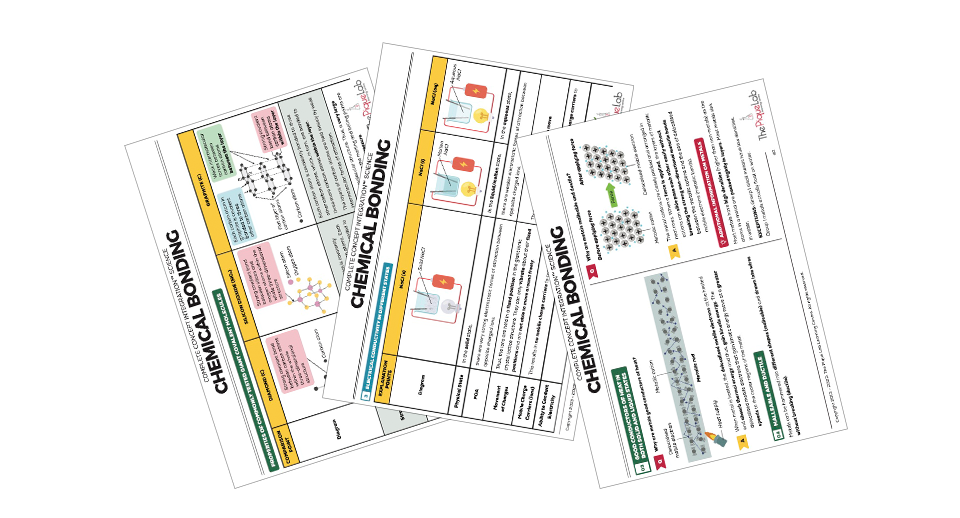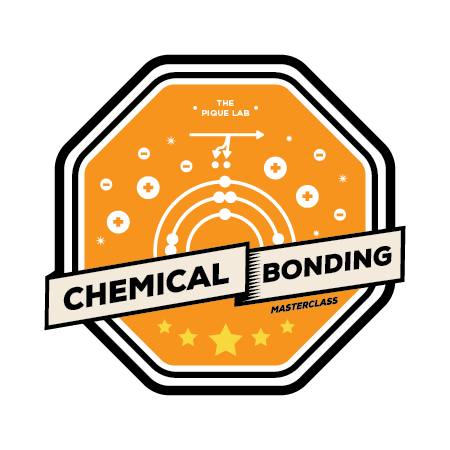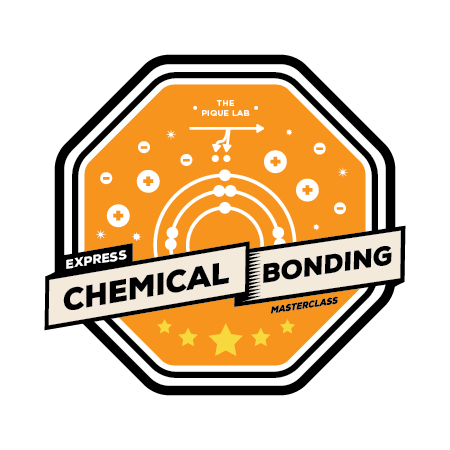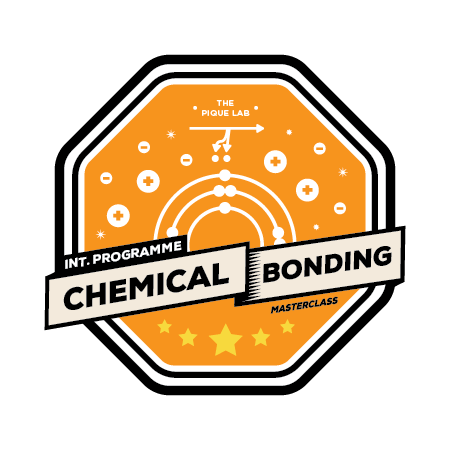
S$397/S$547
S3/4 Content Mastery Course
Become Great At Tackling Questions on
“Chemical Bonding”!
What Your Child Will Be Learning
During this content-packed masterclass, we’ll work closely with your child to improve his/her answering techniques to tackle questions on the topic of Chemical Bonding.
🧱 Understand Key Science Concepts, Master Various Question Trends & Question Types
We’ll help to break down complex Chemical Bonding concepts using coloured illustrations, comparison charts and worked examples. Next, we’ll help your child relate these concepts to different scenarios so that he/she is better able to understand how these concepts work.
Our S3 Chemical Bonding Masterclass is all about understanding various examination question trends and question types & how to apply our tested and proven answering techniques to tackle these questions.
Knowing how questions may possibly be tested during examinations will help your child understand what to study and how to study. This also means that your child will be better equipped to tackle similar questions during his/her examinations and hence will be able to process these questions a lot faster than his/her peers.
If your child diligently reviews and applies what we’ve taught, he/she will definitely make progress in their abilities to tackle Chemical Bonding questions.
🚀 Valuable Examination-centric Resources To Accelerate Understanding
Your child will NOT leave this workshop empty-handed.
Not only will our Chemistry Specialists take your child through the step-by-step process of tackling Chemical Bonding questions, we’ll also provide your child with beautifully-illustrated notes, worksheets and worked examples that are designed to help students learn this topic easier, better and faster.
These valuable resources will help to shorten the learning curve tremendously. You and your child can expect to save lots of valuable time and frustration trying to figure out what examination setters are looking out for.
Here’s a sample of what your child will receive…

💣 Avoid ‘Concept Traps’ That Cause Most Students To Lose Marks Unnecessarily
It is important to have an understanding of the common conceptual pitfalls so that your child can learn to avoid them. We also included little ‘warning notes’ to remind students of potential misconceptions in their syllabus.
Do not underestimate these tips as they will help your child improve the odds of scoring an A1 for his/her Science examination!

S3 Chemical Bonding Masterclass
- Level Eligibility: Secondary 3 & 4
- O-Level (Express) (Sessions 1 & 2 ONLY)
- IP/ IB/ IGCSE (Sessions 1 & 2 & 3)
- Session(s): 2 OR 3 (Depending on academic track)
- Total Duration & Tuition Fee:
- O-Level (Express): $397 for 6 hours (2 x 3 hrs)
- IP/ IB/ IGCSE: $547 for 9 hours (3 x 3 hrs)
- Learning Arrangement:
- Digital Classes
- Onsite Classes* (subjected to changes to National Safe Management Measures)
About Your Child’s Instructors
Your child will be taught by one of these instructors from our Secondary Science Specialist team.
Dr. Ryan Liu Ruoyang
Chemistry Specialist
As a Chemistry Ph.D. holder from the National University of Singapore (NUS), Dr. Ryan is extremely proficient in demystifying complex Secondary Science concepts for his students. His strength lies in formulating and asking thoughtful questions that help his students identify their misconceptions and inculcate the critical thinking skills required to excel in the subject. He is also highly skilled in using in-class demonstrations and discussions to bolster their conceptual comprehension and ignite a genuine curiosity for the subject.
As the valedictorian of the Faculty of Science Commencement 2023 and consecutive Dean’s List recipient during his undergraduate studies at the National University of Singapore (NUS), he leverages his wide range of technical and teaching expertise amassed over more than 11 years to impart not only important Secondary Science concepts and examination-centric strategies to his students, but also a deep passion for learning that has inspired many of his students to pursue meaningful academic growth.

Here’s What Your Child Will Receive
When your child enrolls today, he/she can look forward to gaining access to:
- 6/9 Hours of Lesson Time on Chemical Bonding
- Beautifully Illustrated Science Notes
- Question Booklet Containing Questions & Adapted From Past Year Examination Papers For Application
- Additional Practice Questions For Extra Hardworking Students!
Course Details
Session 1
IP/ IB/ IGCSE Track
O Level (Express) Track
Ionic Bonding
- Describe the Periodic Table as an arrangement of the elements in the order of increasing proton (atomic) number.
- Describe how the position of an element in the Periodic Table is related to metallic/non-metallic character.
- Describe the elements in Group 18 (the noble gases) as a collection of monoatomic elements that are chemically unreactive.
- Describe the formation of ions by electron loss/gain and that these ions usually have the electronic configuration of a noble gas.
- State and derive the charges of common cations and anions (including polyatomic ions).
- Understand and derive the name and chemical formula of ionic compounds.
- Master the writing of chemical formulas using the cross-multiplication method.
- Describe, including the use of ‘dot-and-cross’ diagrams, the formation of ionic bonds between metals and non-metals.
- State that ionic materials contain a giant lattice in which the ions are held by electrostatic attraction.
- Relate the physical properties (including electrical property) of ionic compounds to their lattice structure.
Covalent Bonding I
- Describe the formation of a covalent bond by the sharing of a pair of electrons and that the atoms in the molecules usually have the electronic configuration of a noble gas.
- Understand and derive the name and chemical formula of covalent compounds.
- Describe, using ‘dot-and-cross’ diagrams, the formation of covalent bonds between non-metallic elements, and deduce the arrangement of electrons in other covalent molecules.
Session 2
IP/ IB/ IGCSE Track
O Level (Express) Track
Covalent Bonding II
- Relate the physical properties (including electrical property) of covalent substances to their structure and bonding.
- Compare the structures of the following substances to deduce their properties:
- Simple molecular substances
- Macromolecules
- Giant covalent substances
- Compare the bonding and structures of diamond and graphite to deduce their properties such as electrical conductivity, lubricating or cutting action.
- Deduce the physical and chemical properties of substances from their structures and bonding and vice versa.
Metallic Bonding
- Describe metals as a lattice of positive ions in a sea of electrons.
- Describe the general physical properties of metals as solids having high melting and boiling points, malleable, good conductors of heat and electricity in terms of their structure.
- Describe an alloy as a mixture of metal with another element.
- Identify representations of metals and alloys from diagrams of structures.
- Explain why alloys have different physical properties to their constituent elements.
Session 3
IP/ IB/ IGCSE Track
Covalent Bonding III
- Describe, including the drawing of various representations (e.g. ‘dot-and-cross’ diagram) for ionic bonding, covalent bonding and co-ordinate (dative covalent) bonding.
- Describe and explain qualitatively the general trends and variations in electronegativity.
- Deduce the formulae of ionic compounds from diagrams of their lattice structures.
- Describe covalent bonding in terms of orbital overlap, giving σ and π bonds.
- Describe and give examples of the exceptions to octet rule.
- Explain the shapes of, and bond angles in, molecules with trigonal planar, linear, tetrahedral, trigonal pyramidal and bent geometries by using the Valence Shell Electron Pair Repulsion theory.
- Predict the shapes of, and bond angles in, molecules analogous to those specified above.
- Explain and deduce bond polarity using the concept of electronegativity.
- Deduce the polarity of a molecule using bond polarity and its molecular shape.
- Describe the following forces of attraction (electrostatic in nature) and the factors affecting them:
- Intermolecular forces, based on permanent and induced dipoles
- Hydrogen bonding
- Describe, interpret and/or predict the effect of different types of structure and bonding on the physical properties of substances.
- Suggest the type of structure and bonding present in a substance from given information.
Visualise The Digital Experience
Here's How We Make It Easy For Parents & Students
Visualise The Onsite Experience
Here's How Keep Your Child Safe With Enhanced Measures
From the beginning, your child's safety and well-being have always been important to us. We will be adopting a series of government-mandated measures to make our onsite experience as safe as possible for our learners.

SafeEntry Registration & Temperature Screening
Every student authorised to attend onsite lessons will need to report to the Temperature Screening Station before attending the class:
(i) Undergo health screening (temperature taking & health declaration)
(ii) Check in via TraceTogether-Only SafeEntry if the following conditions are met:
- You/your child have not had close contact with a confirmed COVID-19 case in the past 14 days
- You/your child are not currently under a Quarantine Order or Stay-Home Notice
- You/your child do not have a fever or flu-like symptoms
- You/your child agree to the terms and consent to the collection and use of your information for the purpose of COVID-19 contact tracing
✳️ Please ensure that your child brings along his/her TraceTogether token or mobile phone with the TraceTogether App to facilitate the SafeEntry processing.
⚠️NOTE:
(1) The TraceTogether Token or App is mandatory from 1 June 2021 onwards. Students without the token or the app will not be allowed to enter the premises.
(2) SafeEntry Check-in via SingPass or Mobile QR code will no longer be accepted from 17 May 2021 onwards. Scanning of barcodes on personal identification cards to check in to venues will still be allowed until 31 May 2021.
(3) If your child is living in the same household as a family member who is unwell, he/she should not be attending his/her onsite lesson for that particular week.
(4) Students and staff who are unwell (i.e. fever or respiratory symptoms) will not be allowed to enter our premises.
(5) Students and staff who are on Health Risk Warning (HRW) are encouraged to minimise unnecessary social interactions and may only be allowed to enter the centre if they produce photoevidence of a negative Antigen Rapid test (ART) taken on that day.

Disinfection Between Classes & Regular, Extensive Sanitisation Efforts
Classrooms will also be thoroughly sanitised before and after classes.
We have also stepped up our sanitisation efforts in classrooms and common areas with the use of NEA-approved professional cleaners.
Deep cleaning by fogging non-toxic, skin-friendly chemicals have also been scheduled on a weekly basis.

Revised In-Class Seating Arrangement
Students attending onsite lessons will be split into groups of 5 with at least 1-metre distancing between groups.
As much as possible, we will attempt to assign onsite classes across all of our classrooms in the other units on the same level to avoid intermingling between students.
Entry/exit timings of all students will also be staggered.




Use of Masks
All students will be required to wear a mask at the Centre. Students can choose to wear a face shield on top of a mask for additional protection if desired.

Easy Access to Sanitisers
Automated hand sanitiser dispenser machines have also been installed along all common areas for students to use when necessary.

Safe Distancing Control In Common Areas
Aside from the installation of safe distancing markers on the ground, safe distancing ambassadors will also be deployed to remind students to keep a safe distance from each other.
As much as possible, parents who are picking up their children should make pick-up arrangements at Level 1 to avoid crowding the waiting areas.

Changes to Reception Operations
Our Reception will also remain CLOSED for enquiries and payment.
If you would like to learn more about our programmes or products, please contact us via WhatsApp, Email or Live Chat.
S3 Chemical Bonding Masterclass Details
Two Tracks For Students In O-Level (Express) AND IP/ IB/ IGCSE Track

O Level (Express) Track
Hello There!
There are NO available S3 Chemical Bonding Masterclass (O Level – Express) at this point in time.
If you’d like to be given the heads up when our enrollments open, please fill in the Interest Check form below.
Thank you! 🙂

IP/ IB/ IGCSE Track
Hello There!
There are NO available S3 Chemical Bonding Masterclass (IP/IB/IGCSE) at this point in time.
If you’d like to be given the heads up when our enrollments open, please fill in the Interest Check form below.
Thank you! 🙂
Course Registration Form
Please fill in the following form accurately.
Note: You’ll be redirected to a confirmation page after the above registration has been successfully processed.

